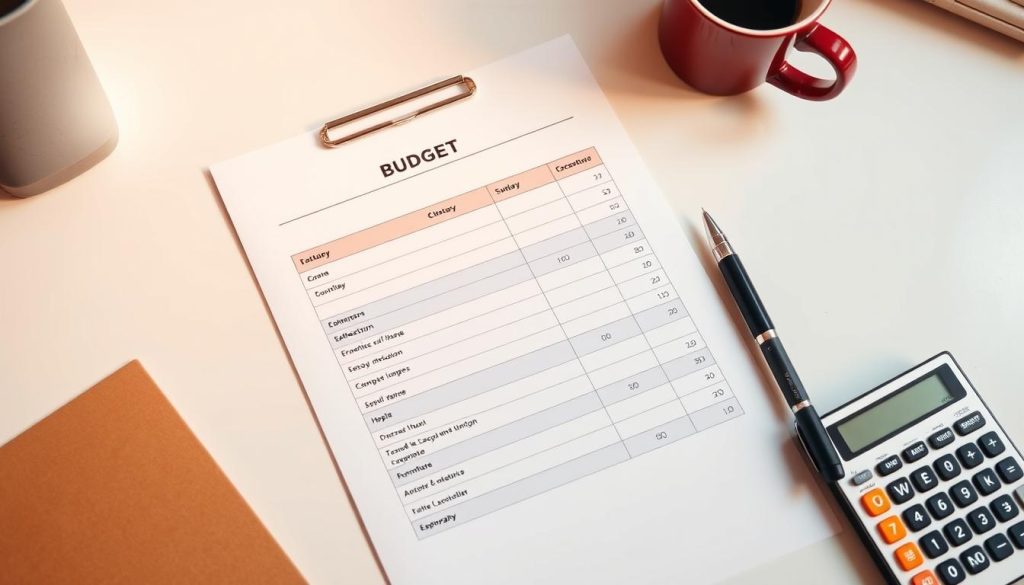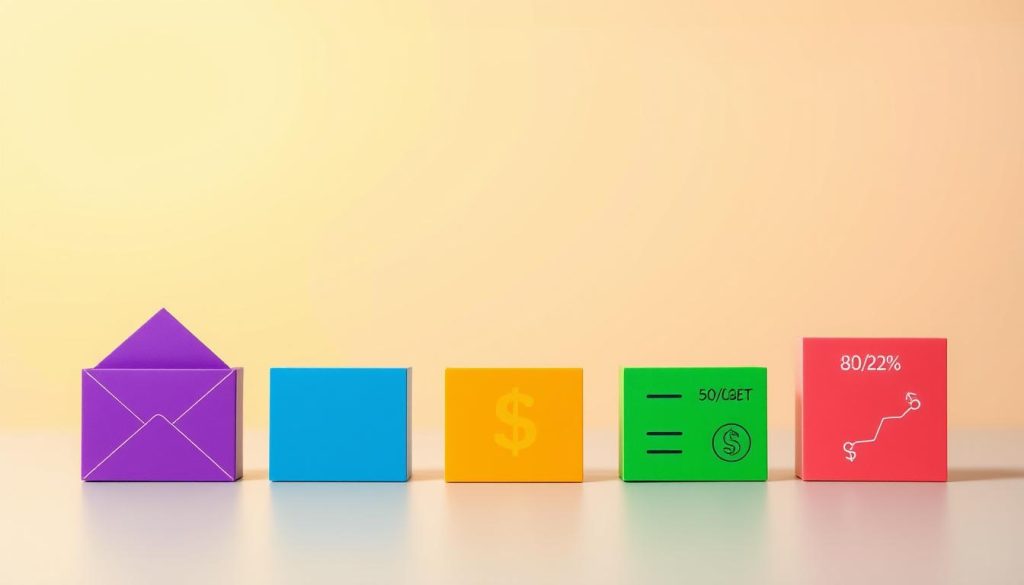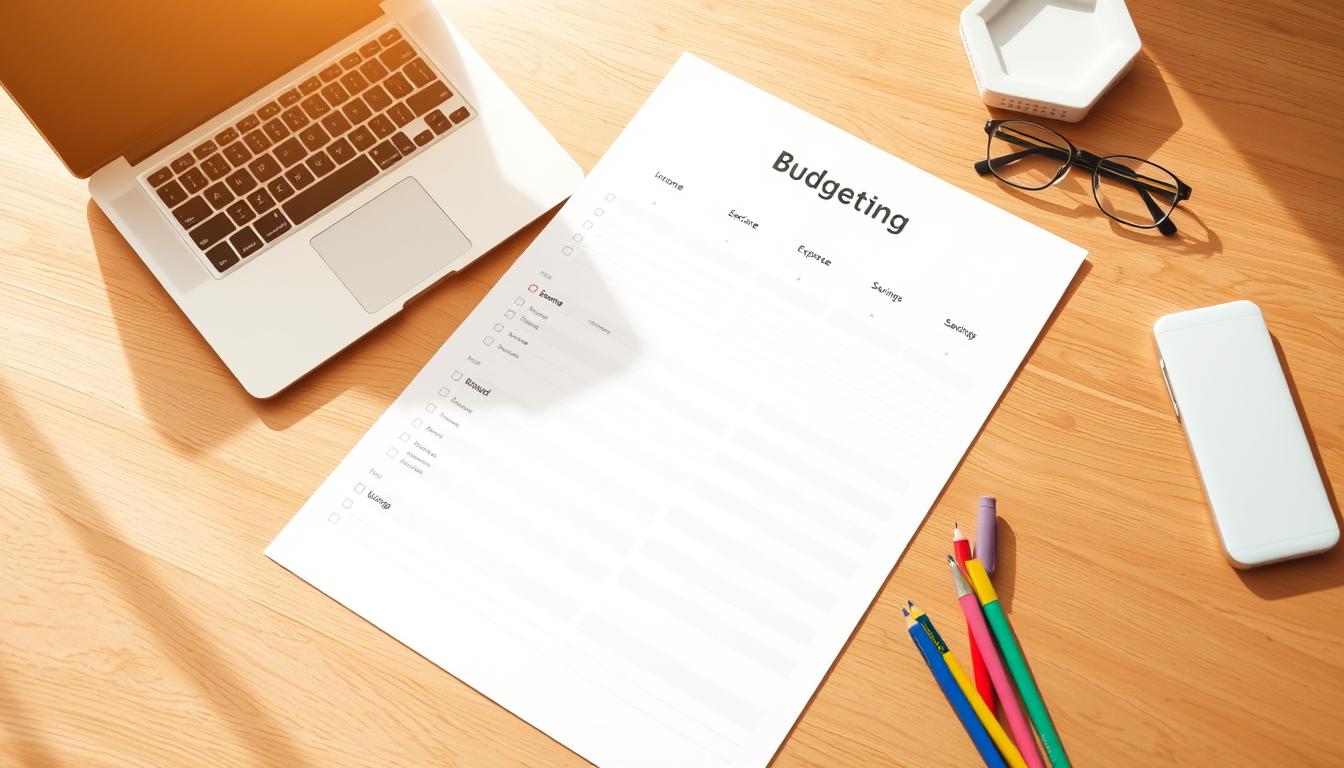Budgeting is key to financial success. It helps you save for big things like a home or pay off debt. A good budgeting template makes your dreams real.
This guide shows you how to manage your money. You’ll learn to track every dollar and save better. Every expense will help you reach your goals.
Getting your finances in order starts with knowing your income. Over 60% of Americans don’t budget, but those who do save more. Tools like the 50/30/20 rule help you spend wisely.
Start by knowing where your money comes from. Then, sort your expenses and save first. Even small steps can make a big difference.
Key Takeaways
- A budgeting template simplifies tracking income and expenses.
- 60% of Americans skip budgeting, missing opportunities to save.
- The 50/30/20 rule splits income into needs, wants, and savings.
- Regular budget reviews boost financial confidence and reduce stress.
- Emergency funds and retirement savings are core to long-term stability.
Why Is Budgeting Important for Financial Success
Understanding budgeting is key. It’s not just about tracking money. It’s a guide to reach your goals, like paying off debt or saving.
By focusing on budgeting, you see where your money goes. This makes it easier to spend on what’s important.
The Connection Between Budgeting and Financial Goals
A budget is like a GPS for your money. For example, the 50/30/20 rule helps split your income. It makes sure you save for emergencies and pay off debt first.
Without a budget, big dreams like owning a home or retiring might seem far away.
How Regular Budgeting Improves Financial Decision-Making
Deciding on dinner without a budget is common. Budgeting teaches you to be disciplined. It helps you track spending and avoid impulse buys.
Studies show that budgeting can turn anxiety into action. It helps you feel confident in your financial choices.
Statistics on Budgeting Impact on Wealth Building
Only about 30% of households budget. But those who do grow their wealth three times faster. Budgeting helps entrepreneurs manage cash flow better.
Even small changes, like cooking at home, can make a big difference. Budgeters save faster, pay off debt sooner, and sleep better knowing their money is working for them.
Common Misconceptions About Budgeting That Hold You Back
Budgeting isn’t about saying no to fun. It’s about choosing what’s most important to you. There are many types of budgeting to match your life, like the envelope system or apps.
Some think they don’t need a budget because they earn enough. Or that it takes too much time. But even small steps can make a big difference. For example, 60% of people who track their spending feel more in control.
Another myth is that budgeting is only for those in trouble. But 75% of freelancers use budgets to manage their income. Budgeting is about freedom, not limits. It helps you save for fun, emergencies, and more.
Do you think you need to be a math expert to budget? Tools like Mint or YNAB make it easy. Experts say start by saving 20% of your income. Even simple methods, like cash envelopes, can help more than nothing at all.
Lastly, budgeting is not a one-time thing. You need to check and adjust it often. The goal is to find a method that works for you. Remember, a budget is a guide to financial freedom, not a prison.
Getting Started: Essential Financial Information to Gather
“A budget helps individuals manage their money by providing a clear picture of monthly income and expenses.”
Before you start budgeting, collect all your financial papers. List every way you make money and sort out your spending. Use a budgeting tool like Mint or Excel to help. These tools are key to good budgeting in accounting.
Creating Your Income and Expense Categories
First, write down all the ways you earn money. This includes your job, freelance work, or side jobs. Then, group your spending into fixed (like rent) and variable (like eating out) costs. Tools like YNAB or QuickBooks can help with this. Make sure your categories fit your spending style.
Organizing Your Financial Documents
Put your receipts, bank statements, and tax papers in order. Use cloud storage like Google Drive or apps like Shoeboxed. This makes it easy to update your budgeting tool and track your spending.
Setting Realistic Financial Goals
Make goals using the SMART method. For example, aim to save $500 for an emergency by December. SMART goals can increase your success by 42%. Check your goals every month and change them if needed, using your budgeting in accounting tool.
Step 1: Tracking Your Income and Understanding Your Money Sources
Knowing where every dollar comes from is key to smart budgeting. Over 40% of households don’t track their income. This leads to overspending.
List every income source, like paychecks or freelance work. Then, figure out your net income after taxes. For example, a $3,000 monthly gross income becomes $2,500 net after deductions. This shows your true spending power.
Have variable income? Average earnings over three months to plan better. Tools like spreadsheets or apps help track income. Holborn Assets, managing $2 billion, says: “Budgeting starts with knowing where your money comes from. Without it, even small leaks drain savings.”
After knowing your income, subtract fixed costs like rent ($1,450) and insurance ($200). Then, subtract variable expenses like groceries ($400). This shows a $300 monthly surplus for savings.
Review your income monthly to adjust as life changes. Small steps today build financial stability tomorrow.
Step 2: Analyzing Your Spending Patterns and Expense Categories
Start by looking at every single transaction. A budgeting template helps sort expenses into fixed, variable, and discretionary groups. This shows what you spend on must-haves versus nice-to-haves.
Spreadsheets or apps can make tracking easier. They help you see spending trends.
Fixed vs. Variable Expenses: What’s the Difference?
Fixed costs, like rent or insurance, don’t change every month. They often take half of your income. Variable costs, like food or gas, change more often.
Tracking these helps you plan your budget better. A budgeting template can help with this.
Identifying Needs vs. Wants in Your Budget
Needs are things like utilities, healthcare, and food. They are essential for living. Wants are things like subscriptions or eating out. They are not as important.
A budgeting template can sort these for you. It helps you cut back on non-essentials without feeling bad. The 50/30/20 rule suggests spending 50% on needs, 30% on wants, and 20% on savings.
Finding Hidden Money Leaks in Your Finances
Small expenses like unused streaming services or daily coffee add up. Looking at your transactions can reveal these. For example, $5 a day for coffee is $150 a month.
A budgeting template can show these patterns. It helps you save money instead of wasting it.
By regularly checking your spending, you can make better choices. Even small changes, like cutting subscriptions or meal prepping, can save money. This step helps you create a budget that fits your life.
Step 3: Creating a Personalized Budgeting Template That Works
First, pick a budgeting template that fits your life. Microsoft Excel has free templates for tracking income and expenses. For instance, if you make $500 a week, you can easily add it to the template.

Look into different types of budgeting. The 50/30/20 rule is one way. It says spend 50% on needs, 30% on wants, and 20% on savings. Zero-based budgeting means every dollar is used for something.
Make your template your own by adding special categories. Single parents might add a line for childcare. Retirees could track health costs. The summary sheet should show income, expenses, and savings in a donut chart.
Try your template for 30 days. If fixed costs are too high, move money from wants to needs. Check it weekly for a month, then monthly. A good budget helps you reach goals and meet daily needs.
Step 4: Implementing Your Budget with Practical Strategies
Putting a budget into action needs more than just wanting to. These steps make it a habit. Use technology and smart systems to help.
The Envelope Method for Cash Management
The envelope system helps control spending. Use cash in labeled envelopes for things like groceries or fun. When the cash is gone, you can’t spend more.
Digital budgeting tools like YNAB or Mint work the same way. For example, they can remind you when you’ve spent too much on groceries.
Zero-Based Budgeting Techniques
Zero-based budgeting means every dollar is used. Start with your total income and assign each dollar to needs like rent or savings. No money left over.
Apps like EveryDollar help plan this out. They make sure every expense has a reason. The goal is to have income minus expenses equal $0.
Automation Tips for Easier Budget Maintenance
Automation makes budgeting easier. Set automatic transfers for savings or bills. Link your budget to budgeting apps that update your bank accounts.
These apps can send money to savings automatically. Start by saving 10% of your income first. Most banks let you schedule transfers to match your paydays.
Step 5: Reviewing and Adjusting Your Budget for Long-Term Success
Regular reviews make your budget alive. Use a tool like You Need a Budget (YNAB) to watch your spending. Change your budget when your life changes, like getting a new job or unexpected bills.
Being consistent is key, but being flexible is also important. It keeps your budget real and achievable.
“Budgeting isn’t about rigidity—it’s about adaptability. Regular reviews help you stay aligned with your goals without feeling restricted.”
monthly review process>Check your spending each month. See how it compares to your budget. Note where you spent too much and where you saved more.
Use your budgeting tool to find patterns. Small changes now can avoid big problems later.
quarterly financial check-ins>Every three months, look at bigger trends. See how you’re doing on saving or paying off debt. If you’re spending too much on housing, find ways to cut costs.
Check if your emergency fund is growing. Aim for 3–6 months of expenses saved.
when to revise your budget categories>Change your budget after big life changes, like losing a job or getting a raise. If your priorities change, adjust your budget too. For example, if you’re saving for a house, increase your savings.
The goal is a budget that grows with you, not stays the same.
Types of Budgeting Methods to Match Your Personality
Choosing the right budgeting style starts with knowing your financial personality. For example, detail-oriented people might like zero-based budgeting. Spontaneous thinkers might prefer flexible approaches like reverse budgeting.

Introverts who like structure often do well with the envelope system. They track cash for things like groceries and bills. Big-picture thinkers might use the 50/30/20 rule, dividing income into needs, wants, and savings.
Analysts and planners might like zero-sum budgets, where every dollar has a purpose. Explorers might enjoy reverse budgeting, setting goals first then funding them.
Data shows 25% of users find the envelope method cuts impulse buys by 50%. 40% of freelancers prefer zero-based budgets for their irregular incomes. For example, INFJs might use value-based budgets, focusing on experiences over material goods.
ENTPs could try investment-focused strategies. ISFPs might focus on experience funds for creativity.
Remember, the best budgeting method is the one you’ll stick to. Try the “Track Every Penny” approach if you struggle with spending awareness. It reduces discretionary spending by 30% for many. Whether you’re minimalist, spontaneous, or analytical, the right budgeting turns financial goals into habits that feel natural.
Best Budgeting Apps and Tools for Different Financial Situations
Managing money is easier with the right tool. Budgeting apps help track income, expenses, and savings. They come in free and paid versions, each with special features for different needs.
“YNAB users save an average of $600 in the first two months by tracking every dollar.”
Free vs. Paid Budgeting Software Options
Free apps like Honeydue and Credit Karma track spending for free. Paid apps like YNAB or Monarch cost $109 or $99.99 a year. They offer more features like zero-based budgeting or tracking investments.
Budgeting Apps for Beginners
Apps for new users are easy to use. Mint connects to bank accounts and sorts spending. Goodbudget helps control spending with the envelope method. Honeydue lets couples share budgets without fees.
Advanced Tools for Experienced Budgeters
For those who need more, apps like YNAB offer zero-based budgeting. Monarch has unlimited collaborators for family planning. Personal Capital tracks net worth. Paid apps also include tax planning and 24/7 support.
Specialized Budgeting Approaches for Different Life Stages
Life’s phases bring unique financial challenges. Adapting your budget ensures it stays effective as your circumstances shift. Let’s explore strategies tailored to three key stages.
Budgeting for Students: Managing Loans and Limited Income
Students juggle tuition, textbooks, and part-time work. Start by listing all income sources—from scholarships to campus jobs. Prioritize essentials like rent and groceries.
Use student discounts and meal-planning to stretch budgets. Even small monthly savings build an emergency fund. Apps like Mint or You Need A Budget help track spending.
Remember, budgeting for students lays the groundwork for lifelong financial habits.
Family Budgeting Strategies
Households thrive with shared goals. Combine incomes and list all expenses—from daycare to retirement savings. Allocate funds for both fun and future, like vacations and college funds.
Hold regular family meetings to adjust plans. Teach kids about money by involving them in decisions. Tools like shared Google Sheets keep everyone aligned.
Retirement Budgeting Considerations
Retirees face fixed incomes and rising healthcare costs. Review fixed expenses like housing and insurance. Cut discretionary spending to preserve savings.
Explore Medicare plans and consider downsizing homes. Why is budgeting important here? It ensures longevity of funds while enjoying retirement years without financial stress.
Whether in school, raising a family, or enjoying retirement, flexibility is key. Regular reviews keep budgets aligned with life’s changes.
Conclusion: Transform Your Financial Future Through Consistent Budgeting
Budgeting is key to financial stability. It helps you spend wisely and reach your goals. This could be paying off debt or saving for a home.
The 50/30/20 rule is a good guide. It says spend 50% on needs, 30% on wants, and 20% on savings. Tools like Mint or YNAB make tracking easier. Regular checks keep your plan up-to-date.
Writing down financial goals can boost success by 42%. Start by listing what’s important to you. Automate savings and check your budget every month. Also, save 3-6 months’ worth of expenses for emergencies.
Small changes can make a big difference. Cut back on subscriptions or adjust your budget weekly. Talking about money with your partner can also help you both succeed.
Start today by listing all your expenses. Set a goal for the next 7 days, like eating out less. Use apps to track your progress. Budgeting is not about saying no to fun. It’s about finding freedom.
With regular updates and the right strategies, you can achieve wealth. Your financial future is waiting for you.




